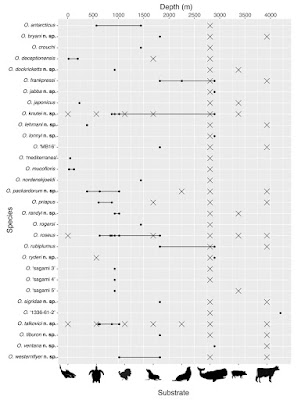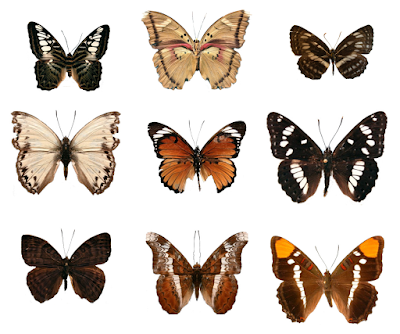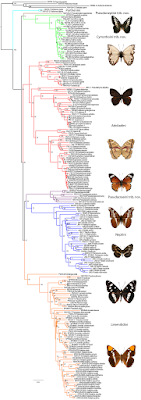[Most Recent Entries] [Calendar View]
Monday, February 5th, 2018
| Time | Event | ||
| 3:52a | [Invertebrate • 2018] An Inordinate Fondness for Osedax (Siboglinidae: Annelida): Fourteen New Species of Bone Worms from California
Abstract We incorporate DNA sequences from a comprehensive sampling of taxa to provide an updated phylogeny of Osedax and discuss the remarkable diversity of this clade of siboglinids. We formally describe 14 new species of Osedax from Monterey Bay, California, USA, raising the total number of properly named Osedax species to 25. These new species had formerly been recognized by informal names in various publications, and on GenBank. The descriptions document the occurrence of dwarf males in five of the new species. The distribution for the 19 species of Osedax known to occur in Monterey Bay across depths from 385 to 2898 meters and various bone substrates is documented. The exploitation of extant bird and marine turtle bones by Osedax is reported for the first time. Key words: Siboglinidae, Annelida Siboglinidae Caullery, 1914 Osedax Rouse, Goffredi & Vrijenhoek 2004 Remarks. This diagnosis is revised from that in Rouse et al. (2004) to accommodate the diversity of Osedax forms. These include Osedax jabba n. sp. where the females lack palps entirely and Osedax priapus where the males are not paedomorphic dwarfs, but also consume bone and have similar anatomy to females. Many Osedax species have palps that lack obvious pinnules. The dorsal placement of the oviduct reflects the reorientation of Osedax as reported in Huusgaard et al. (2012) and Worsaae et al. (2016). Osedax sigridae n. sp. Distribution. Known from Monterey Bay, California from 1820 meters depth (Table 2). It has been found in whale and cow bones. Etymology. This species is named (noun in the genitive case) for Sigrid Katz, whose Ph.D. project involved detailed study of the anatomy of this species (Katz et al. 2010; Katz et al. 2011). Osedax talkovici n. sp. Distribution. Known from Monterey Bay, California from 633 to 1018 meters depth (Table 2). It has been found in whale, elephant seal, cow, turkey, turtle and teleost bones. Etymology. This species is named (noun in the genitive case) for Mark Talkovic, Senior ROV pilot for MBARI, who collected many bones containing Osedax over the years. Osedax tiburon n. sp. Distribution. Known from Monterey Bay, California from 1820 meters depth (Table 2). Etymology. This species is named (noun in apposition) for the ROV Tiburon, which was used to collect the first Osedax specimens. Osedax ventana n. sp. Distribution. Known from Monterey Bay, California from 2898 meters depth (Table 2). It has only been found in experimentally deployed cow bones. Etymology. This species is named (noun in apposition) for the ROV Ventana, which was used to collect many Osedax specimens. Osedax docricketts n. sp. Distribution. Known from Monterey Bay, California from 1820 meters depth, and Sagami Bay, Japan (Table 2). It has been found living on cow and whale bones. Etymology. This species is named (noun in apposition) for the ROV Doc Ricketts, which was used to collect many Osedax specimens. Osedax westernflyer n. sp. Distribution. Known from Monterey Bay, California from 1820 meters depth and Sagami, Bay Japan (Table 2). It has been found in cow and whale bones. Etymology. This species is named (noun in apposition) for the Research Vessel Western Flyer, which has been critical to Osedax studies. Osedax knutei n. sp. Distribution. Known from Monterey Bay, California from 1018 to 2898 meters depth (Table 2). It has been found in whale, cow, turkey and teleost bones. Etymology. This species is named (noun in the genitive case) for Knute Brekke, Chief ROV pilot for MBARI, who expertly collected many bones and Osedax over the years. Osedax lonnyi n. sp. Distribution. Known from Monterey Bay, California from 2898 meters depth (Table 2). It has only been found in a whale bone fragment, adjacent to the main skeleton. Etymology. This species is named (noun in the genitive case) for Lonny Lundsten, Senior Research Technician at MBARI, for his enthusiasm and assistance on many Osedax expeditions. Osedax ryderi n. sp. Distribution. Known from Monterey Bay, California from 2898 meters depth (Table 2). It has been found in whale and turtle bones. Etymology. This species is named (noun in the genitive case) for Ryder Williams, for his generosity in sharing his mom for our research efforts. Osedax jabba n. sp. Distribution. Known only from Monterey Bay, California from 2898 meters depth (Table 2). Osedax jabba n. sp. was only found in sediment surrounding the natural whale fall at this depth (Figs 9A-D). Most specimens were at the head end of the whale, near a mass of baleen (Fig. 9A). All had bone fragments attached to the root mass buried in the sediment. Etymology. The trunk of the new species is reminiscent of the tail of the mythical creature Jabba the Hutt from the Star Wars franchise (Sansweet 1998). We name the new species (noun in apposition) in its honor. Osedax lehmani n. sp. Distribution. Known from Monterey Bay, California only from 349 meters depth (Table 2). It has been found in whale and cow bones. Etymology. This species is named (noun in the genitive case) in memory of Alan George Lehman, father of Ellen Lehman, in recognition of her long and continued support of the Scripps Oceanographic Collections. Osedax packardorum n. sp. Distribution. Known from Monterey Bay, California at 349, 633, and 1018 meters depths (Table 2). Found in whale and cow bones. Etymology. This species is named (noun in the genitive case) in honor of the Packard family whose foundation supports MBARI and enabled the discovery of all of the Osedax species in California. Osedax randyi n. sp. Distribution. Known from Monterey Bay, California from 1018 meters depth, and from Sagami Bay, Japan (Table 2). It has been found in whale and cow bones. Etymology. This species is named (noun in the genitive case) in honor of Randy Prickett, Senior ROV pilot for MBARI, who collected many bones and Osedax over the years. Osedax bryani n. sp. Distribution. Known from Monterey Bay, California from 1820 meters depth in whale bone. Etymology. This species is named (noun in the genitive case) in honor of Bryan Touryan-Schaefer, ROV Pilot/ Technician for MBARI, who collected many bones with Osedax over the years. Greg W. Rouse, Shana K. Goffredi, Shannon B. Johnson and Robert C. Vrijenhoek. 2018. An Inordinate Fondness for Osedax (Siboglinidae: Annelida): Fourteen New Species of Bone Worms from California. Zootaxa. 4377(4); 451–489. DOI: 10.11646/zootaxa.4377.4.1 | ||
| 7:34a | [Entomology • 2018] Molecular Systematics of the Subfamily Limenitidinae (Lepidoptera: Nymphalidae) Abstract We studied the systematics of the subfamily Limenitidinae (Lepidoptera: Nymphalidae) using molecular methods to reconstruct a robust phylogenetic hypothesis. The molecular data matrix comprised 205 Limenitidinae species, four outgroups, and 11,327 aligned nucleotide sites using up to 18 genes per species of which seven genes (CycY, Exp1, Nex9, PolII, ProSup, PSb and UDPG6DH) have not previously been used in phylogenetic studies. We recovered the monophyly of the subfamily Limenitidinae and seven higher clades corresponding to four traditional tribes Parthenini, Adoliadini, Neptini, Limenitidini as well as three additional independent lineages. [Cymothoini, Pseudoneptini and Pseudacraeini] One contains the genera Harma + Cymothoe and likely a third, Bhagadatta, and the other two independent lineages lead to Pseudoneptis and to Pseudacraea. These independent lineages are circumscribed as new tribes. Parthenini was recovered as sister to rest of Limenitidinae, but the relationships of the remaining six lineages were ambiguous. A number of genera were found to be non-monophyletic, with Pantoporia, Euthalia, Athyma, and Parasarpa being polyphyletic, whereas Limenitis, Neptis, Bebearia, Euryphura, and Adelpha were paraphyletic. Conclusion: This study presents the most comprehensive phylogenetic analysis to date for the “trash-can” subfamily Limenitidinae. Based on fragments of up to 18 genes per species, 205 species and four outgroups, our results recovered Limenitidinae as a monophyletic clade and which comprises seven major lineages that deserve tribal status. Four tribes have been traditionally recognized: Parthenini, Neptini, Adoliadini, and Limenitidini, while three lineages are placed in new tribes here: Cymothoini, Pseudoneptini and Pseudacraeini. The new Cymothoini tribe includes two African genera Cymothoe and Harma, and quite likely an Asian genus Baghadatta. The latter two new tribes are monogeneric. At the genus level, we found several traditionally recognized genera to be either poly- or paraphyletic, i.e., Neptis, Euryphura, Pantoporia, Athyma, Parasarpa, Limenitis, and Adelpha. Further work increasing the taxon sampling is necessary to test the monophyly of these genera and revise their limits. Bidur Dhungel and Niklas Wahlberg. 2018. Molecular Systematics of the Subfamily Limenitidinae (Lepidoptera: Nymphalidae). PeerJ. 6:e4311. DOI: 10.7717/peerj.4311 |
| << Previous Day |
2018/02/05 [Calendar] |
Next Day >> |






